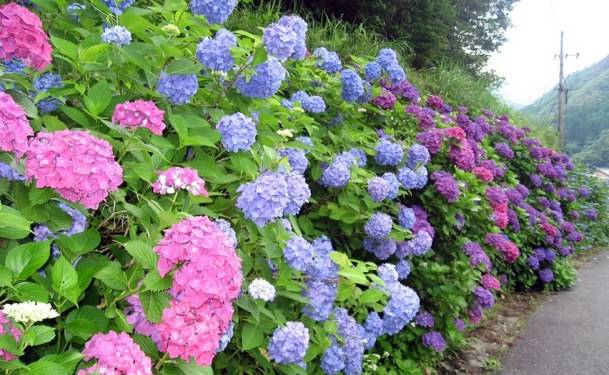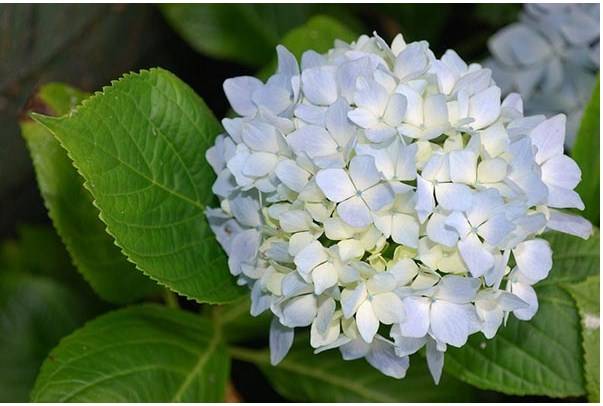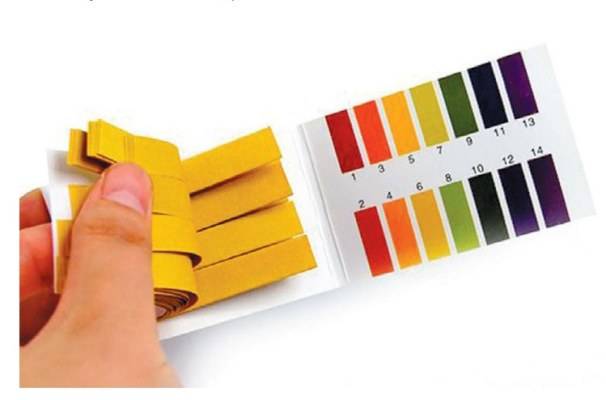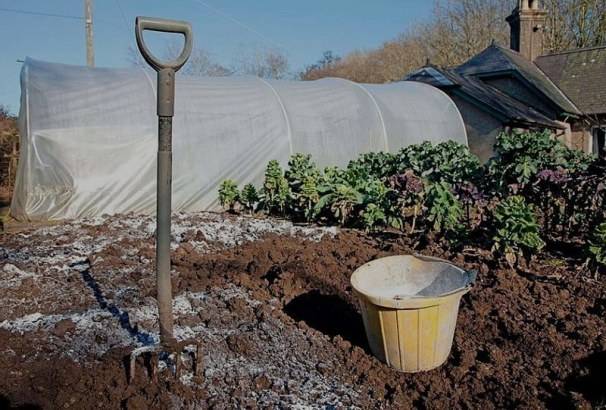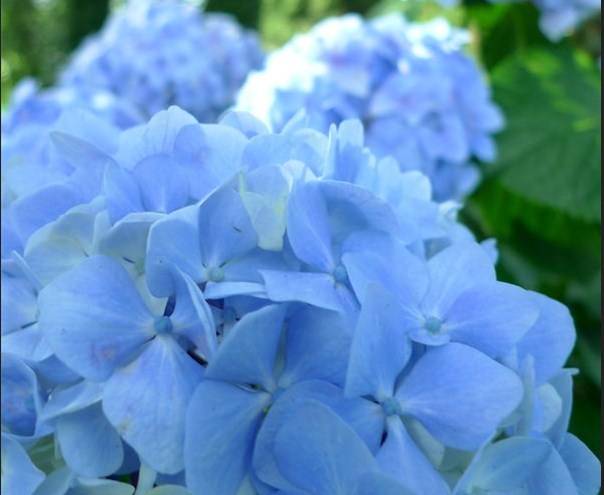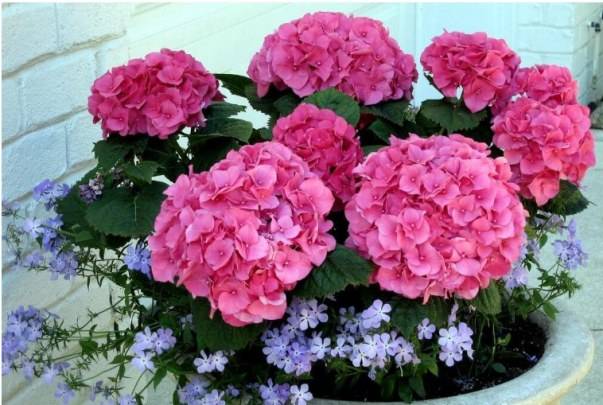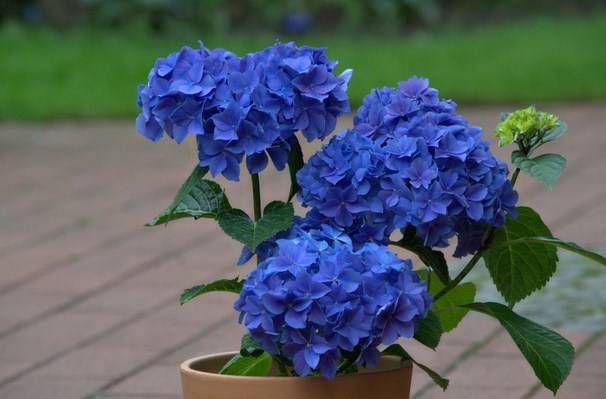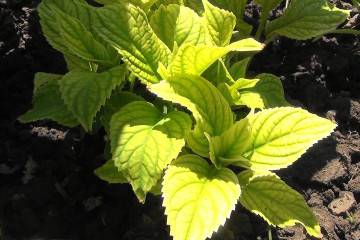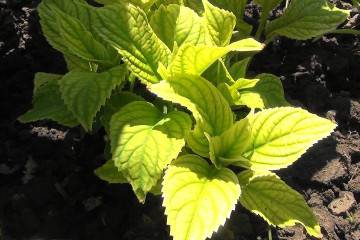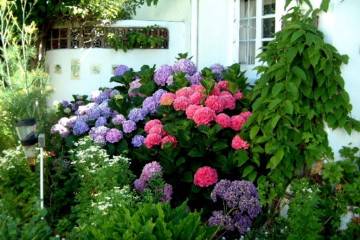How to change the color of a hydrangea and make a hydrangea blue
Content:
- What determines the color of the flower
- How to determine the acidity of the soil yourself
- What drugs do you need to have on hand to change the acidity of the soil
- How to water a hydrangea to change its color
- How to grow a blue hydrangea
- How to change the color to pink
- How to make a blue beauty in the garden
- How to change the color of hydrangea from white to pink with folk remedies
You can often hear from gardeners that hydrangea flowers changed color after transplanting a shrub. This property of the plant can be used to diversify the area with different shades of inflorescences. This article explains how to change the color of a hydrangea.
What determines the color of the flower
The shade of the buds depends on the composition of the soil in which the bush grows. Chemical elements present in the soil in different parts of the garden in different concentrations can affect the color of hydrangea petals. If you know how a certain mineral affects the color of the petals, you can change the colors of the flowers on the bushes in the garden. The composition of the earth can be changed by adding organic matter or chemicals. They are brought directly under the bush.
In acidic soil, the shrub is covered with blue and blue flowers. In a neutral and alkaline environment, the buds turn white and purple. To know how to water the hydrangea so that it turns blue, the gardener must determine the composition of the soil.
How to determine the acidity of the soil yourself
To find out the alkaline balance of the soil, you need to take a closer look at what weeds are growing on the site. Woodlice, runny, horsetail, sorrel, plantain indicate that the earth is acidic. In such soils, the hydrangea will bloom blue. Weeds like clover, coltsfoot, bindweed, nettle love alkaline soil.
You can quickly and easily determine the soil composition with vinegar. It is poured over dry land. If bubbles appear on the surface, then the soil has a high alkali level.
Garden shops also sell litmus test strips, which are dyed in different colors in response to the acidity level of the measured substrate.
After determining the acid-base soil composition, you can decide how to water the hydrangea to change the color of the buds.
What drugs do you need to have on hand to change the acidity of the soil
Additives are applied under the bush directly to the soil surface or by dropping them onto a shovel bayonet. To adjust the composition of the substrate, you need to have dolomite flour, peat, organic fertilizers, butchery, and apple cider vinegar on hand. What to add to the soil is decided after determining the acidity of the earth.
Folk remedies to change the acidity of the soil
There are simple techniques to increase the acidity of the soil on the site:
- Sprinkle the soil near the trunk circle with a layer of coniferous litter and chopped pine bark.
- Loosen the soil around the bush and feed it with peat, rotted manure.
- Water the ground once a week with a solution of apple cider vinegar.
It is important not to overdo it, because the high content of alum can lead to root rot.To reduce acidity, dolomite flour, ash, lime are added to the soil mixture.
How to water a hydrangea to change its color
Hydrangea belongs to crops with variable shade of buds. You need to water the plant with additives before planting in the ground, when it is still in the container. After planting in the garden, you can use the buds to test the composition of the soil. If a blooming hydrangea changes its color from pink to white or blue, the earth can be said to be acidic. Conversely, blue flowers fade and become pink in color, which means the substrate is alkaline.
It is necessary to change the alkaline composition of the soil even before bud break. The soil must be saturated with chemical elements before planting young seedlings in the ground or before budding on old bushes. Maintenance of the acidic composition of the earth is carried out throughout the summer.
A perennial shrub can be in one place in the garden for several years and not change the shade of the petals. If the gardener decides to change the color of the buds in the current season, then he should add coloring additives in early spring so that the soil has time to be saturated with chemicals before the hydrangea blooms.
Chemicals are applied to the soil in the summer period, at intervals of 1-2 times a week. To prevent the coloring elements from being washed out by the rain, it is advisable to plant a colored hydrangea in open ground in containers.
How to grow a blue hydrangea
Before making the hydrangea blue, you need to change the acidity of the soil in which the shrub grows. The composition should be of medium acidity. A pH level above 5.5 is considered alkaline. In such soil, a heavenly shade of colors cannot be achieved. A high level of alkali will give the flowers a red tint. The soil is acidified with peat, manure, compost, pine needles. During the entire growing season, the alkaline balance is maintained by adding an aqueous solution of acetic acid under the bush in a ratio of 10: 1.
The procedure is carried out 2 times a month. The effect is enhanced if a solution of potassium sulfate is added to the soil during the flowering period. This substance is highly important for the dissolution of aluminum in the soil.
From the time of bud ovary until the end of flowering, every week, 500 grams of dry aluminum sulfate should be poured under the bush, which maintains the blue hue of the buds. 2 times a year, a solution of aluminum alum should be poured under each tree. The mixture is prepared in a ratio of 40 grams of substance per 10 liters of water.
How to change the color to pink
Hydrangea flowers turn pink by spilling the soil with a weak potassium permanganate concentrate. The alkaline composition of the soil mixture should be from 6 to 6.5 pH. It is important not to exceed this figure, since the high content of manganese inhibits the photosynthesis of the plant, and the shrub eventually dies.
To reduce acidity, dolomite or ash is added to the substrate. During prolonged rains, alkaline mixtures are washed out of the ground, their balance will change, so chemicals must be added regularly to maintain the pink hue of the inflorescences. The pH level should be maintained with regular nitrogen and phosphorus feeding.
How to make a blue beauty in the garden
Experienced gardeners know how to water the hydrangea so that it changes color from blue to blue. During the growing season, aluminum sulfate with potassium supplements should be added under the root of the plant. The higher the concentration of this substance, the brighter the shade of the petals. To get a persistent blue color, you need to dilute 10 tbsp in a bucket of water. l. aluminum sulfate and water the plant (1 bucket per 1 bush). This solution should be watered with hydrangea every 2 weeks.
You need to know that in an alkaline environment with a high phosphorus content, aluminum will not give the desired reaction. That is why mineral fertilizers with phosphorus compounds are prohibited for blue flowers. Before feeding with aluminum, the acidity of the soil is increased to 4.5-5.5 pH using peat, organic matter.
To maintain high acidity, every week, a bucket of citric acid solution, prepared in a proportion of 2 tbsp, is poured under the tree. l. for 10 liters of water. Oxalic acid or sulfur can be used for the solution, but these substances are not readily available on the market. At home, it is easier to water with lemon.
How to change the color of hydrangea from white to pink with folk remedies
The color of the petals can only be changed by applying a large dose of chemicals to the soil. In addition to standard watering with a manganese solution, dolomite flour and chalk are poured under the root every week. This will give the petals a pink tint.
It should be borne in mind that large doses of potassium permanganate can burn the leaves and root system of the plant, so the dosage of the drug should be minimal. It is better to water with a solution of lower concentration, but more often.
Potassium permanganate in the composition of the solution should be no more than 1%. Manganese has a positive effect on the growth of the shrub. The concentration of the substance in the crown of the plant creates immunity against the development of putrefactive bacteria, prolongs the flowering period, and improves the flexibility of the stems.
Before you paint the hydrangea in a different color with the help of chemicals, you need to know that there should be no planting of vegetables and berry crops near the shrub. With proper care, observing safety measures, you can get bright hats of flowers of various colors.
